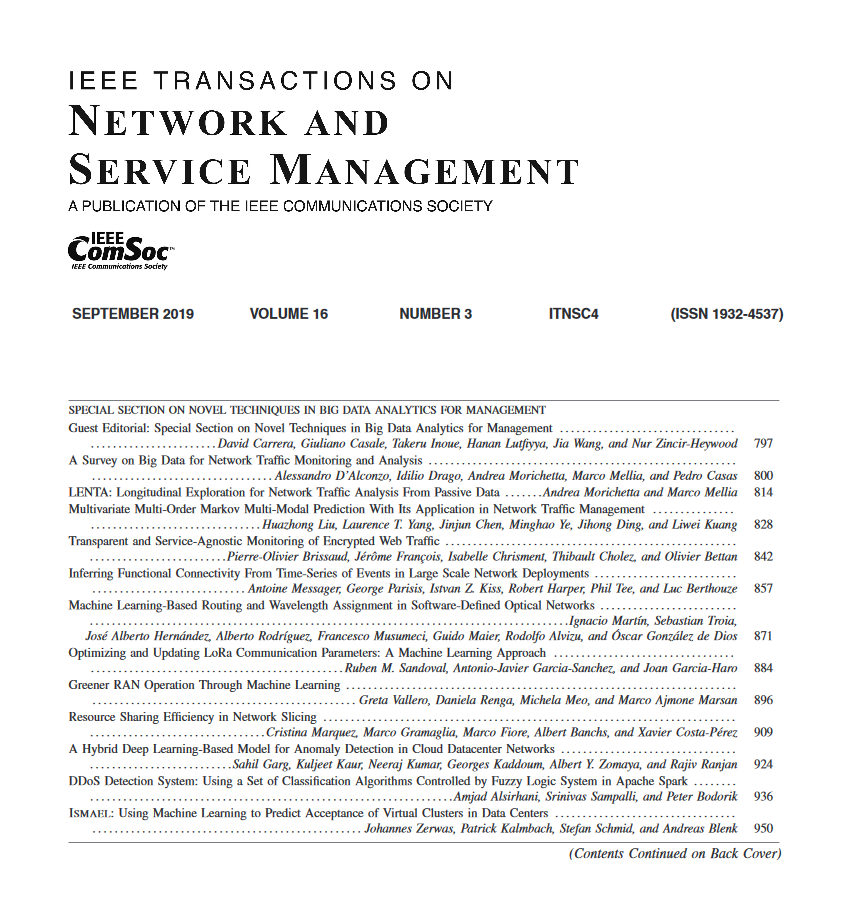Semi-Supervised Learning for Anomaly Traffic Detection via Bidirectional Normalizing Flows
IF 5.4
2区 计算机科学
Q1 COMPUTER SCIENCE, INFORMATION SYSTEMS
IEEE Transactions on Network and Service Management
Pub Date : 2025-07-22
DOI:10.1109/TNSM.2025.3591533
引用次数: 0
Abstract
With the rapid development of the Internet, various types of anomaly traffic are threatening network security. However, the difficulty of collecting and labelling anomalous traffic is a significant challenge, so this paper proposes a semi-supervised anomaly detection framework. Considering normal and abnormal traffic have different data distributions, our framework can generate pseudo anomaly samples without prior knowledge of anomalies to achieve the detection of anomaly data. The framework comprises three principal components. Firstly, a pre-trained feature extractor is employed to extract a feature representation of the network traffic. Secondly, a bidirectional normalizing flow module establishes a reversible transformation between the latent data distribution and a Gaussian space. Through this bidirectional mapping, samples first undergo transformation manipulation within the Gaussian distribution space, and are then transported through the generative direction of normalizing flows, translating mathematical transformations into semantic feature evolutions in the latent data space. Finally, a simple classifier explicitly learns the potential differences between anomaly and normal samples to facilitate better anomaly detection. During inference, our framework requires only two modules to detect anomalous samples, leading to a considerable reduction in model size. According to the experiments, our method achieves the state-of-the-art results on the common benchmarking datasets of anomaly network traffic detection. Furthermore, it exhibits good generalisation performance across datasets.基于双向归一化流的半监督学习异常流量检测
随着互联网的快速发展,各种类型的异常流量正在威胁着网络的安全。然而,异常流量的收集和标记困难是一个重大挑战,因此本文提出了一种半监督异常检测框架。考虑到正常流量和异常流量的数据分布不同,我们的框架可以在没有异常先验知识的情况下生成伪异常样本,从而实现异常数据的检测。该框架包括三个主要部分。首先,使用预训练的特征提取器提取网络流量的特征表示。其次,双向归一化流模块建立了潜在数据分布与高斯空间之间的可逆变换。通过这种双向映射,样本首先在高斯分布空间内进行变换操作,然后通过归一化流的生成方向进行传输,将数学变换转化为潜在数据空间中的语义特征演化。最后,一个简单的分类器明确地学习异常和正常样本之间的潜在差异,以便更好地进行异常检测。在推理过程中,我们的框架只需要两个模块来检测异常样本,从而大大减少了模型大小。通过实验,我们的方法在异常网络流量检测的常用基准数据集上取得了最先进的结果。此外,它在数据集上表现出良好的泛化性能。
本文章由计算机程序翻译,如有差异,请以英文原文为准。
求助全文
约1分钟内获得全文
求助全文
来源期刊

IEEE Transactions on Network and Service Management
Computer Science-Computer Networks and Communications
CiteScore
9.30
自引率
15.10%
发文量
325
期刊介绍:
IEEE Transactions on Network and Service Management will publish (online only) peerreviewed archival quality papers that advance the state-of-the-art and practical applications of network and service management. Theoretical research contributions (presenting new concepts and techniques) and applied contributions (reporting on experiences and experiments with actual systems) will be encouraged. These transactions will focus on the key technical issues related to: Management Models, Architectures and Frameworks; Service Provisioning, Reliability and Quality Assurance; Management Functions; Enabling Technologies; Information and Communication Models; Policies; Applications and Case Studies; Emerging Technologies and Standards.
 求助内容:
求助内容: 应助结果提醒方式:
应助结果提醒方式:


